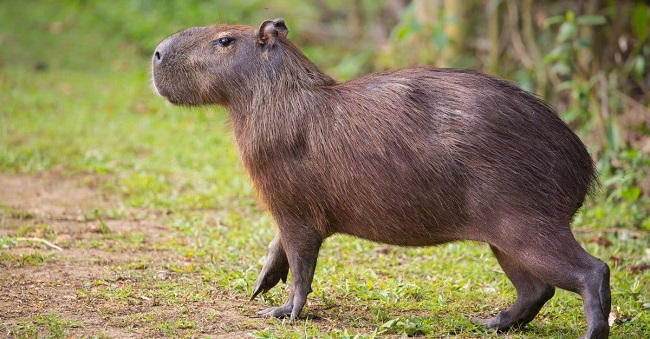When we think of rodents, small creatures like mice and hamsters might come to mind. But the family of rodents extends beyond these familiar faces to include the Largest Rodent in the world: the Capybara.
This intriguing mammal, native to South America, boasts a unique lifestyle and distinct physical attributes that set it apart. This article aims to provide an in-depth look at the Capybara, exploring its habitat, behavior, and role in the ecosystem.

The Capybara: An Overview
The Capybara (Hydrochoerus hydrochaeris), also known as the water pig, is an exceptional creature. It can weigh up to 140 pounds and measure up to 4.5 feet in length, making it the largest living rodent on Earth.
Read Also:
Where Do Capybaras Live?
Capybaras inhabit the savannas and dense forests of South America. They’re found near bodies of water, such as rivers, lakes, and swamps, across several countries, including Brazil, Argentina, and Venezuela.
Capybara Characteristics
Here are the characteristics of Cypybara:
Physical Attributes
Capybaras have a barrel-shaped body covered with coarse, reddish-brown hair, small ears, and larger nostrils located on top of their snout for better adaptation to their semi-aquatic lifestyle.
Semi-Aquatic Adaptations
Capybaras are excellent swimmers, thanks to their webbed feet. They can stay underwater for up to five minutes to escape predators.
The Capybara Diet
Capybaras are herbivores, primarily eating grasses and aquatic plants. They also consume fruits and bark. Their large incisors never stop growing, an adaptation shared with other rodents.
Behavior and Lifestyle
Capybaras are social animals, usually living in groups ranging from 10 to 20 members. These groups consist of a dominant male, several females, and their offspring.
Capybaras and Ecosystem Interactions
Capybaras play an essential role in their ecosystems. They serve as a food source for many predators, and their grazing behavior helps control vegetation.
Challenges to Capybara Populations
Like many wildlife species, capybaras face threats from habitat loss and hunting. However, they are currently listed as a species of least concern by the International Union for Conservation of Nature (IUCN).
Capybara Reproduction
Here is the reproduction cycle to Capybara:
A Fascinating Cycle
Capybara reproduction is another aspect that makes these creatures unique. Female capybaras, also known as capybara cows, have a gestation period of approximately 150 days.
They usually give birth to a litter of 1-8 pups, with the average being around 4. Interestingly, the newborn capybaras are well-developed at birth. They have their fur, their eyes are open, and they are able to follow their mother almost immediately.
Social Structure and Breeding
Capybaras live in hierarchical groups dominated by one alpha male, who has exclusive breeding rights with the females in the group. This dominant male will defend his group from other males and predators. Breeding typically happens year-round but peaks during the rainy season.
Capybaras and Human Interaction
Here is human infection related to the capybaras:
Capybaras in Zoos and Reserves
Capybaras are popular attractions in zoos and wildlife reserves worldwide due to their calm demeanor and intriguing social behavior. These venues offer an opportunity for people to learn about these remarkable rodents and their vital role in the ecosystem.
Domestication and Pets
Capybaras have been domesticated in some parts of their range for their meat and hides. In some areas, they are also kept as exotic pets.
However, owning a capybara as a pet requires a great deal of space, a suitable environment, and an understanding of their social needs.
Before considering a capybara as a pet, it’s important to check local laws and regulations as ownership may be illegal in some areas.
Read Also:
Conclusion
The Capybara, with its remarkable size and intriguing characteristics, brings diversity and balance to the rodent family and its habitats.
As the Largest Rodent in the world, the Capybara is a testament to the diverse, adaptable nature of the rodent family and a fascinating subject for those interested in wildlife.
By understanding more about these unique creatures, we can appreciate the rich biodiversity of our planet and the importance of preserving it.
























